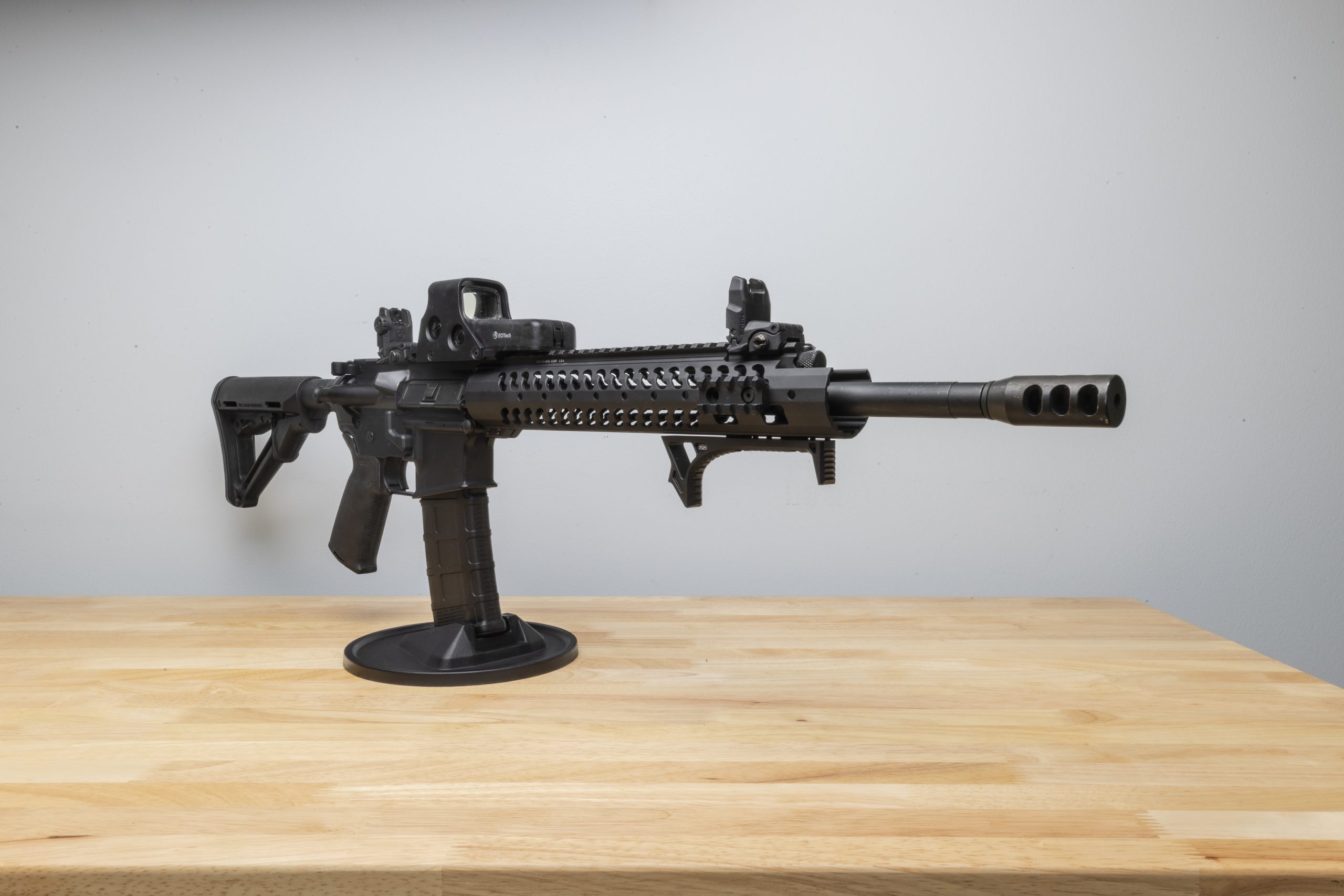
Categories:
The AR15 rifle, also known as the Armalite Rifle 15, is a widely recognized and versatile gun that has gained popularity among gun enthusiasts, law enforcement agencies, and military personnel. Developed in the late 1950s by Eugene Stoner, this semi-automatic rifle quickly became an iconic symbol of American guns engineering. The AR15 operates on a gas-operated direct impingement system. When a round is fired, a portion of the high-pressure gas generated from the ignited cartridge is directed back into the action through a tube located above the barrel.
This gas then pushes against a bolt carrier group, causing it to move rearward and ejecting the spent casing. As the bolt carrier group travels back forward under spring tension, it strips another round from the magazine and chambers it for firing.
The AR15, also known as the ArmaLite Rifle-15, is a popular semi-automatic rifle that has gained significant attention over the years for its reliability and versatility. To understand how this gun operates, it is essential to familiarize oneself with its basic components. At the heart of an AR15 is the upper receiver assembly, which houses crucial elements such as the barrel, bolt carrier group, and charging handle.
The barrel serves as the conduit for propelling projectiles by harnessing expanding gases from each round fired. Connected to the barrel is the bolt carrier group (BCG), responsible for extracting spent casings and chambering fresh rounds. The lower receiver assembly houses important components like the trigger assembly, magazine well, pistol grip, and stock attachment point. The trigger assembly allows for controlled firing by releasing the hammer when pulled.
The magazine well accommodates detachable magazines that hold ammunition.
The gas-operated system of the AR15 is a critical component in understanding its function. When a round is fired, the expanding gases generated by the ignited gunpowder are directed through the barrel towards the muzzle. A small portion of these gases is tapped off from a hole located near the muzzle and directed back into a gas block. From there, the gas enters a gas tube that runs beneath the handguard and connects to the upper receiver.
The gas tube directs this high-pressure gas towards a bolt carrier key located at the top of the bolt carrier group. As pressure builds up, it forces the bolt carrier group rearward against spring tension. This backward movement extracts and ejects spent casings while simultaneously compressing and re-cocking the hammer for subsequent rounds. As it reaches its rearward position, spring tension pushes the bolt carrier group forward again, picking up another round from the magazine and chambering it.
This ignites the primer in the cartridge, causing rapid expansion of gases that propel the bullet down the barrel. 4. Unlocking: After firing, as pressure drops in the barrel, gas is vented through a port in front of it, driving back a piston or directly impinging on a bolt carrier group (BCG). This unlocks and extracts spent casing from the chamber.
To comprehend how the AR15 functions, it is crucial to grasp its firing cycle. The process begins when the shooter pulls the trigger, activating the hammer. As the hammer strikes, it hits a firing pin that ignites a primer in the chambered round. This ignition produces a small explosion that propels the bullet forward through the barrel. Simultaneously, gas generated from this explosion is redirected through a gas port located near the front sight base.
This gas enters a tube and travels back towards the bolt carrier group (BCG). The BCG contains multiple components: a bolt, firing pin, and cam pin. As gas forces its way into an expansion chamber inside the BCG, pressure builds up and causes it to move rearward. This backward motion unlocks and extracts an empty casing from the chamber while simultaneously cocking back the hammer for subsequent rounds.
The AR15, a popular semi-automatic rifle, operates using a gas piston system that enables its reliable and efficient functioning. In this subtopic, we will delve into the various modes of operation that make the AR15 a versatile gun. Firstly, the direct impingement mode is the most common operating system found in an AR15. Here, high-pressure gas is redirected from the barrel to push the bolt carrier group backward, cycling the action and chambering a new round.
Secondly, some variants utilize a short-stroke gas piston system. Instead of directing gas directly into the receiver, this mode employs a separate piston to drive back the bolt carrier group. This design reduces fouling within the gun and enhances reliability under adverse conditions. Lastly, another alternative is the delayed blowback mechanism which delays unlocking until pressure drops to safe levels before extracting and chambering another round.
In conclusion, the AR15 operates on a gas-operated, direct impingement system that functions by utilizing the gases produced from firing a round to cycle the gun. This gas system is responsible for extracting and ejecting spent cartridges while also chambering new rounds. The bolt carrier group plays a crucial role in this process, as it houses the bolt and is responsible for cycling back and forth within the upper receiver.
The AR15’s semi-automatic functionality allows for rapid-fire capabilities with each pull of the trigger resulting in a single shot fired. The rifle’s modular design provides users with various customization options and ease of maintenance.
Understanding how the AR15 functions helps emphasize its reliability, accuracy, and widespread use among civilians, law enforcement agencies, and military personnel alike. Its unique operating system has made it one of the most popular guns in America today.








Colt
Colt M4 Carbine
Colt LE6920
Colt AR-15 A4
Daniel Defense
DDM4 V7
DDM4 V9
DDM4 V11
DDM4 ISR (Integrally Suppressed Rifle)
Smith & Wesson (S&W)
M&P15 Sport II
M&P15 Tactical
M&P15T
Bravo Company Manufacturing (BCM)
BCM Recce-16
BCM Recce-14
BCM MCMR Series
Aero Precision
M4E1 Series
AC-15
AR15 Pistol (Various Configurations)
Ruger
Ruger AR-556
Ruger SR-556
Ruger AR-556 MPR (Multi-Purpose Rifle)
Springfield Armory
Saint Victor
Saint Edge
Saint AR-15
PSA (Palmetto State Armory)
PSA PA-15
PSA AR-V
PSA Jakl (AR Pistol)
FN America
FN 15 Tactical Carbine
FN 15 Patrol
FN 15 DMR
Wilson Combat
Recon Tactical
Super Sniper
Protector Carbine
SIG Sauer
SIG M400 Tread
SIG M400 Elite
SIG M400 SDI
LWRC International
IC DI (Direct Impingement)
IC SPR
IC A5
Bushmaster Guns
XM-15 QRC
Bushmaster MOE
XM-15 Patrolman
Rock River Arms
LAR-15 Entry Tactical
LAR-15 Predator
LAR-15 Elite Comp
Stag Arms
Stag 15 Tactical
Stag 15L (Left-Handed Models)
Stag 15 Valkyrie
Noveske Rifleworks
Noveske Gen 4 N4
Noveske Space Invader (AR Pistol)
Noveske Recon
Anderson Manufacturing
AM-15 Optic Ready
AM-15 M4 Carbine
AM-15 Precision Rifle
Adams Arms
AA-15 Piston Rifle
P2 AARS (Adams Arms Rifle Series)
Black Rain Ordnance
SPEC15 Series
BRO Predator
Fallout 15
Diamondback Guns
DB15 Series
DB15CCMLB
DB15EB
Del-Ton Inc.
DTI-15
Del-Ton Echo 316H
Sierra 316M
Windham Weaponry
Windham SRC
Windham VEX-SS
Windham RMCS-4 (Caliber Conversion System)
Christensen Arms
CA-15 G2
CA-15 Recon
CA-15 Titanium Edition
Patriot Ordnance Factory (POF-USA)
Renegade Plus
P415 Edge
Revolution DI
LaRue Tactical
PredatAR
OBR (Optimized Battle Rifle)
LaRue Stealth 2.0
Battle Arms Development
Workhorse Patrol Carbine
BAD556-LW (Lightweight)
Authority Elite Rifle
Faxon Guns
Ascent AR-15
FX-19 (AR Pistol)
Streamline Ultralight Series
KE Arms
KE-15 SLT (Super Lightweight Tactical)
KE-15 Scout Carbine
Primary Weapons Systems (PWS)
MK1 MOD 2-M
MK116 PRO
MK107 (Piston AR Pistol)
ZEV Technologies
ZEV Core Elite Rifle
ZEV AR15 Billet Rifles
Franklin Armory
BFSIII AR-C1
Militia Model
F17-L (Chambered in .17 WSM)
Seekins Precision
SP15 DMR
NX15 Skeletonized Rifle
Havak Bravo
Aero Precision (Additional Models)
EPC-9 (Pistol Caliber ARs)
VG6 AR Rifles
Barrett Guns
REC7 DI
REC7 Gen II
CMMG
MK4 RCE
Resolute 300
Banshee (AR Pistol)
DPMS Panther Arms
Panther Oracle
Panther LR-308
H&K (Heckler & Koch)
HK MR556A1
HK416 (Military Variant)
Rock Island Armory (Armscor)
VR-80 Tactical AR (Shotgun AR Platform)
Troy Industries
Troy SPC-A3
Troy PAR (Pump Action AR)
Wilson Tactical
Tactical Recon AR
Protector Series
F1 Guns
FDR-15 Skeletonized Rifle
BDRx-15 Series
Juggernaut Tactical
JT-15
JT-10 Precision Rifle
AeroSurplus
Surplus AR-15 Rifles (Budget Models)
Thunder Tactical
AR-15 Basic Carbine
Tactical Builder Sets
Radical Guns
RF-15
Forged AR-Series
Dark Storm Industries
DS-15 Featureless Rifles
DS-10 Typhoon
DRD Tactical
Paratus
Aptus AR Rifles
Bear Creek Arsenal
BCA-15
AR Complete Upper Builds
Aero Survival Rifles (ASI)
ASR Tactical Series
Tactical Edge
WARFIGHTER Series
AR-15 Lightweight Rifles
Lone Star Armory
TX15 DMR
TX15 Carbine
HERA Arms
HERA H7
HERA AR-15 Lower Builds
IWI (Israeli Weapon Industries)
Zion-15
DRD Tactical
Tactical Modular Rifles
Quick-Takedown Rifles
V Seven Weapons
1776 Rifle
Hyperlite Rifle
Core Rifle Systems
Core15 Tac III
Core15 Patrol Rifle
Armalite (Original AR-15 Creator)
M15 Tactical
M15 A4 Carbine
DEF15 (Defensive Sporting Rifle Series)
PSA (Palmetto State Armory Additional Models)
PSAK-47 Hybrid (AR-AK Style Hybrid)
PSA Dagger (Pistol Caliber Configurations)
Odin Works
OTR-15
Odin Recon Rifle
Maxim Defense
MDX-508 PDX (Compact AR Pistol)
MDX-510 Rifle